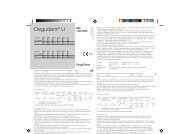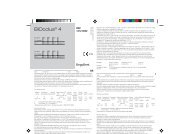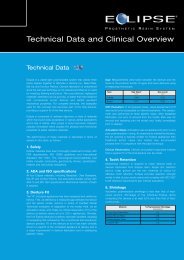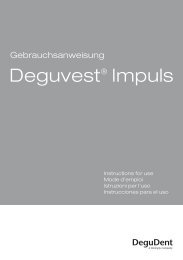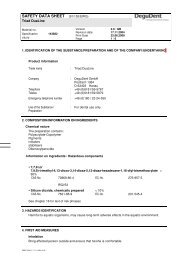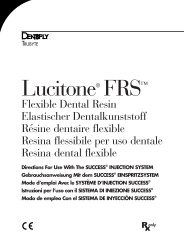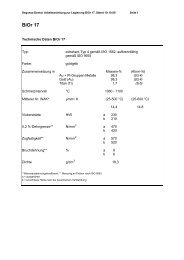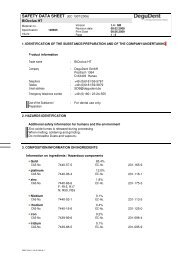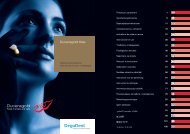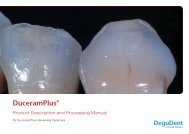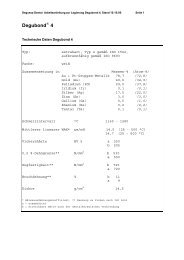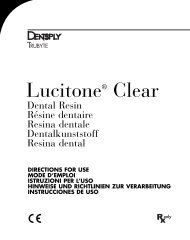Duceram love Guidelines for veneering non-precious ... - DeguDent
Duceram love Guidelines for veneering non-precious ... - DeguDent
Duceram love Guidelines for veneering non-precious ... - DeguDent
Create successful ePaper yourself
Turn your PDF publications into a flip-book with our unique Google optimized e-Paper software.
<strong>love</strong><br />
all you need<br />
D U C E R A M L O V E<br />
<strong>Guidelines</strong> <strong>for</strong> <strong>veneering</strong><br />
<strong>non</strong>-<strong>precious</strong> alloys
Veneering <strong>non</strong>-<strong>precious</strong> alloys: The path to success*<br />
The innovative <strong>Duceram</strong> <strong>love</strong> ceramic <strong>veneering</strong> material can be safely used on <strong>precious</strong> and<br />
<strong>non</strong>-<strong>precious</strong> alloys, <strong>for</strong> a broad range of indications. Since <strong>non</strong>-<strong>precious</strong> alloys and <strong>precious</strong><br />
alloys react differently to ceramic firing, ensure that the following parameters are observed <strong>for</strong><br />
safe <strong>veneering</strong> of <strong>non</strong>-<strong>precious</strong> alloys:<br />
1. Framework design<br />
· The framework must be free of any sharp edges.<br />
· When casting <strong>non</strong>-<strong>precious</strong> alloys, it is recommended to<br />
use only ceramic crucibles and to use only new material.<br />
· Air-abrade the frameworks using 250-µm aluminum<br />
oxide at 4 bar of pressure.<br />
Correct<br />
Incorrect<br />
Surface roughness Very good poor<br />
Ceramics<br />
Ceramics<br />
Anterior crowns<br />
correct<br />
Incorrect<br />
Alloy<br />
Alloy<br />
Correct<br />
250 µm/4 bar 110 µm/2 bar<br />
250 µm/4 bar 110 µm/2 bar<br />
· An oxide firing cycle is recommended to check the framework,<br />
but it is not mandatory. Compartis CoCr frameworks<br />
will have been oxidized at the factory, requiring no separate<br />
oxide firing. Post-finishing of Compartis CoCr frameworks<br />
requires a new round of sandblasting.<br />
Incorrect<br />
Molar crowns<br />
2. NE-Bonder (Powder)<br />
· Wet the surface evenly using a glass instrument.<br />
· Apply a thin covering bonder layer with Ducera Liquid B<br />
or Ducera Liquid OCL universal. Oxides will not be able<br />
to penetrate the layer.<br />
· Heat the bonder to 980 °C at 55 °C/min<br />
(best bond through maximum vitrification).<br />
* This description does not replace the regular Instructions <strong>for</strong> Use.<br />
It is solely intended as a visual guide to aid production.
3. NE Bonder (Paste)<br />
· Apply a covering layer of NE-Bonder Paste with a<br />
paste opaque brush.<br />
· Prior wetting of the framework with a very thin layer of<br />
paste opaque liquid greatly facilitates application of<br />
NE-Bonder Paste.<br />
· Heat the bonder to 980 °C by 55 °C/min (best bond<br />
through complete vitrification).<br />
4. Opaque<br />
· Apply a uni<strong>for</strong>m covering layer of paste opaque.<br />
· Per<strong>for</strong>m the opaque firing at 910 °C.<br />
· The homogenious surface indicates good vitrification<br />
and excellent bond.<br />
· Underfiring will weaken the bond.<br />
5. Build-up<br />
· Ducera Liquid SD is the proven standard liquid <strong>for</strong><br />
single-crown restorations.<br />
· Ducera Liquid Blend is a new modelling liquid ideally<br />
adapted <strong>for</strong> <strong>love</strong> ceramics. Ducera Liquid Blend has the<br />
advantage of excellent shaping properties and longer<br />
working times.<br />
· Ducera Liquid Form also adds stability and has been<br />
specially designed <strong>for</strong> a wide-range of restorations.<br />
SD Blend Form<br />
Modelling liquids<br />
6. Firing<br />
· The <strong>Duceram</strong> <strong>love</strong> firing program has been explicitly<br />
tailored <strong>for</strong> the <strong>DeguDent</strong> range of alloys.<br />
· Third-party alloys must be processed according to the<br />
manufacturers’ Instructions of Use.<br />
· Maximum stability when <strong>veneering</strong> <strong>DeguDent</strong> alloys is<br />
obtained without a tempering phase.<br />
· The highly homogenous material delivers a beautiful<br />
surface lustre.<br />
* Non-<strong>precious</strong> alloys require 6 min of long-term cooling<br />
to relief any stress.<br />
Correct<br />
Heating<br />
55°C/min.<br />
Incorrect<br />
Holding<br />
55°C/min.<br />
Cooling<br />
*<br />
Tempering
22192/1103/Z<br />
Last revision: 03/2011<br />
General firing program<br />
<strong>for</strong> <strong>non</strong>-<strong>precious</strong> alloys<br />
<strong>love</strong><br />
all you need<br />
General<br />
firing programm<br />
NE-Bonder Powder/Paste<br />
Opaque<br />
Shoulder 1<br />
Pre-heating<br />
°C<br />
575<br />
550<br />
500<br />
Drying<br />
Heating Firing<br />
Holding<br />
Pre-drying Closing Pre-heating Vacuum No Vacuum<br />
min.<br />
min.<br />
min. °C/min.<br />
°C<br />
min.<br />
min.<br />
4/6<br />
2<br />
1<br />
55<br />
980<br />
0<br />
2/3<br />
6<br />
2<br />
1<br />
100<br />
910<br />
2<br />
2<br />
1<br />
3<br />
2<br />
100<br />
880<br />
0,5<br />
0,5<br />
Vacuum<br />
hPa<br />
50<br />
50<br />
50<br />
Tempering*<br />
min.<br />
–<br />
–<br />
*3min/850°C<br />
Cooling*<br />
min.<br />
–<br />
–<br />
6*<br />
* For alloys with a CTE above<br />
14.6 μm/m·K (25 – 500°C), shoulder<br />
firing must be extended by a<br />
tempering phase (3 min/850°C)<br />
and a cooling phase (6 min).<br />
Shoulder 2<br />
Dentine 1<br />
Dentine 2<br />
Glaze<br />
FSM / Correction<br />
Stains<br />
500<br />
500<br />
500<br />
500<br />
450<br />
450<br />
1<br />
4<br />
4<br />
0<br />
1<br />
1<br />
3<br />
3<br />
2<br />
2<br />
2<br />
2<br />
2<br />
2<br />
2<br />
2<br />
2<br />
1<br />
100<br />
55<br />
55<br />
55<br />
55<br />
55<br />
860<br />
820<br />
810<br />
800<br />
680<br />
660<br />
0,5<br />
0,5<br />
0,5<br />
–<br />
0,5<br />
0<br />
0,5<br />
0,5<br />
0,5<br />
0,5<br />
0,5<br />
1<br />
50<br />
50<br />
50<br />
–<br />
50<br />
–<br />
*3min/850°C<br />
–<br />
–<br />
–<br />
–<br />
–<br />
6*<br />
6<br />
6<br />
6<br />
–<br />
–<br />
The values listed here are intended <strong>for</strong> orientation only and should be regarded only as guidelines. Your firing results may differ.<br />
All firing results depend on the per<strong>for</strong>mance of the furnace used, which in turn depends on the make, model and age of the furnace.<br />
There<strong>for</strong>e, the guideline values will have to be adapted individually <strong>for</strong> each firing. We recommend running a test firing cycle to evaluate<br />
the per<strong>for</strong>mance of the furnace used. We have compiled and checked all values and other data with great care. However, we cannot<br />
under any circumstances be liable <strong>for</strong> your results.<br />
The firing temperature must be<br />
adjusted to the number of units<br />
fired. Five to ten units require an<br />
increase by 5°C to 10°C; more<br />
than ten units require an increase<br />
by 10°C to 20°C. However, this<br />
does not apply to <strong>non</strong>-<strong>precious</strong><br />
alloys with a CTE above<br />
14.6 μm/m·K (25 – 500°C).<br />
<strong>Duceram</strong> <strong>love</strong> – innovative material design<br />
With conventional ceramics, the properties of leucite are used to control the coefficient of thermal<br />
expansion. With <strong>Duceram</strong> <strong>love</strong>, the preset coefficient of thermal expansion will not change. The<br />
leucite is restricted to a stabilizing function thanks to the homogeneous distribution of the fine leucite<br />
crystals within the glass phase. The internal tension of the ceramic material will be automatically<br />
adjusted to the appropriate value on strict compliance with the suggested firing program.<br />
Conventional ceramics<br />
· Heterogeneous leucite/glass structure<br />
with leucite granules > 50 µm in size<br />
· Component strength 60 – 70 MPa<br />
· Cooling and tempering required to<br />
compensate stress peaks<br />
<strong>Duceram</strong> <strong>love</strong><br />
· Delicate structure of leucite crystals<br />
with granules < 5 µm in size <strong>for</strong> a<br />
homogeneous distribution of tension<br />
during rapid cooling<br />
· Robust component strength at 100 MPa<br />
· No tempering required<br />
<strong>DeguDent</strong> GmbH<br />
Rodenbacher Chaussee 4<br />
63457 Hanau-Wolfgang<br />
Germany<br />
www.degudent.com



